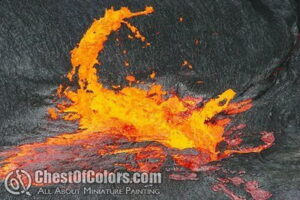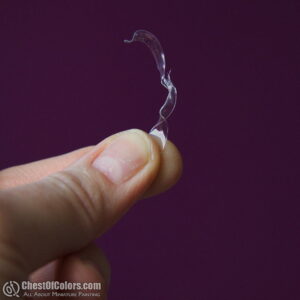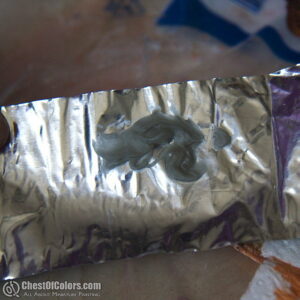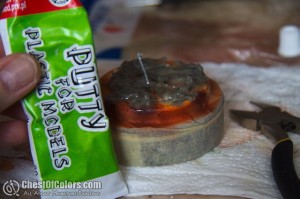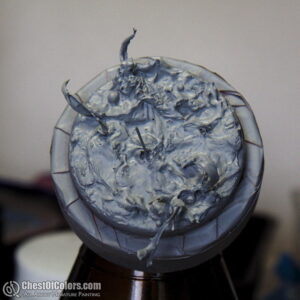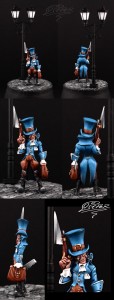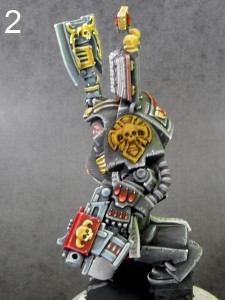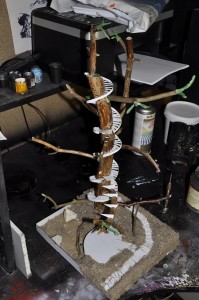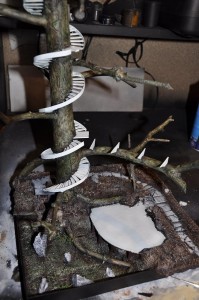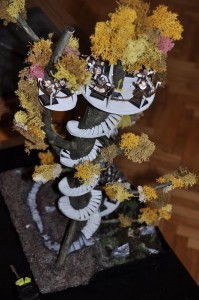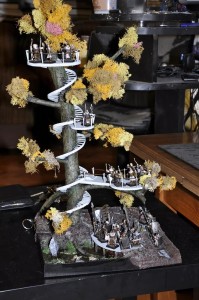This time: Build me a… tree worthy of Lorien! That’s right we’re going to help mother nature make a treetop house ELVENSTYLE! So if you are interested in a How To Build A Tree tutorial – read on:
Components
We’re going to need:- a piece of a branch…a piece of wood that generally resembles a tree.
- a plate of plastic or hard cardboard as a base
- a lot “wavy cardboard” (You know, most boxes are made of it)
- lots of sand
- lots of PVC glue.
- at least 1 pack of green stuff
- water effect
- something that will look like clumps of leaves. I used special modelmaker’s dyed moss.
- some plasticard for the actual platforms for the tree house and the pavement.
- Some static grass, stones, few pieces of natural branches of trees.
- Super glue
- some wire/small iron rods
Tree trunk
So starting the fun of Godlike nature construction. We have to have a tree trunk: make a general idea how the tree house is to look like. I decided on a fixed size of the base and I wanted to add a pond to my tree house. So first you make the base. Use strong cardboard and glue a plate of plasticard to it with super glue. The base MUST be strong as we are about to connect the main trunk.
You have it already? Nice! So let’s get down to the actual tree. If you found yourself a satisfactory piece of wood in the forest and planned the general way the diorama is to look like, cut the branch so that it is more or less flat on one end. Place it on the base and make a hole underneath. Than simply nail the branch through the base so that they stick together. I’ve put like 7 nails and poured some superglue around to make sure it’s not going to come apart.

Surrounding terrain
Now we have a stable base lets start building the terrain. I decided to go easy and started to glue flat pieces of the wavy cardboard. Shaping them as I went so that they would make up the general form of the terrain.


As I went higher and higher I added plates of plasticard so that I could have a cobblestone path and a sort of a by-the-pond boulevard. As mentioned I also started making the banks of the pond. I placed the “stones” on the path using superglue to keep them connected to the cardboard.

Once the general shape of the ground level is done, we start the messy part. This involves a lot of sand so make sure you have some kind of a box. To make the terrain look real we will glue the sand to the wavy cardboard with PVC glue. Pour the glue on a side of “ground” parts and simply throw some sand over the glue. It will stick to the glue and after 2-3 layers you should see a nice round hill.
Make sure that it doesn’t stick to the parts that should be sand-free like things that should be a stoned path.


Branches and roots
Notice that the photographs show some other things which we’ve been doing while the PVC was drying. For one you can see more “branches”. This is done so that the actual tree would look like an actual creation of nature’s product of boredom so we’d expect there would be roots and more branches. We connect those by drilling some holes in the main trunk and in the new branches’ bases. We simply glue the previously prepared pieces of natural shaped branches to our tree. you have to drill both the trunk and the new branch and put an iron rod inside to keep the connection strong and stable! you may use some extra green stuff while gluing them together so it will look smoother.
Remember not to glue the new branches before you finish with the staircase and platforms. Just drill and try the new branches so that the general look of the tree will be satisfactory, than go with the construction of the stairs. It will be much easier this way and after you’re done with the stairs and platforms glue the extra branches to the trunk.
Stairs and platforms
Also you may notice the new side bars added to the pond. This is plasticard that will be black and will be the borders of the pond that are not part of the diorama and are considered open waters. Also we started building the platforms and the road itself. The idea is that the paved path will go around the diorama and eventually change into a stairwell of the tree house.

Now you might notice the stairs are going up the trunk. This is done by making small pieces of plasticard. Cut a few strips of plasticard so that they will be of similar width and that you can cut the stairs-steps one at a time and that all will be roughly the same shape. Than make small, but deep cuts in the trunk and glue the steps in. Try to go up the trunk so that this will look somewhat coherent … you can see the cuts on the photo…I used a small modelmakers’ saw to do this. As we go up you might want to start thinking about the platforms themselves. you can see my first platform on the photo below.

Cut any shape you want and attach the platform in the same manner you did with the stair-steps. However, in this case there might be a fairly obvious need to use additional support like a branch and some adapters below the platform level.

Try not to glue the platforms to the trunk and keep them as separate elements. This will make it easier to build them and to construct the whole diorama. The last thing I did in this part was to glue the platforms in after all the painting and gluing of everything else.
Balustrades
This will help the platforms to be stable and will look better. Once you built the stairs and the platforms you might want to add extra edges to the stairs. This rim will add to the overall construction look and will make you believe it’s made by true craftsman and not an overanxious woodcutter who never got to work for IKEA. The photo also shows some important parts on the platforms. A banister, balustrade or a rail around the platforms will add reality to your creation and will look more natural for a high construction structure. I made this using the iron wire and some plasticard. The best way to do this is to simply shape the wire like the area you want to have a banister around. Than make the plasticard pylons and simply make a hole in each and slip them along the wire. Make a small cut in the platform and glue the whole thing together.
Assembly
Now that we’re done with the platforms the hard part is over. Take the platforms out and glue the previously prepared branches to the trunk. If you want even more branches simply drill some extra holes, put an iron rod in them and form a branch from green stuff. Don’t worry about the actual shape because we’re going to cover them with leaves later on.

Painting
Already done with the branches and platforms, are you? Ok… let’s get down to painting. I took the basic black spray available in any construction market/DIY supermarket. Be generous with the spray as the sand will need at least a few layers. Now I went to paint the platforms and stairs. First I painted them with Citadel‘s Bleached Bone , than gave it 2 layers of Citadel‘s Thraka Green wash. In the end I want for two layers of 75%/25% Skull White and Vallejo glaze medium. This last part was airbrushed.

The same treatment was given to all platforms, but the moveable ones were done separately.

Now with the wood itself:

First I gave all the tree parts a drybrush with Citadel‘s Scorched Earth, than a drybrush of Citadel‘s Graveyard Earth and a drybrush of Citadel‘s Bleached Bone. Than a watered down layer of Citadel‘s Devlan Mud wash, a similar one of Citadel‘s Thraka Green wash and again Devlan Mud wash. If you want you can give it a final wash of Thraka Green again and/or light drybrush of Bleached Bone again.
The ground itself was painted with 3 layers of drybrush (Scorched Brown, Bestial Brown, Bleached Bone). The area which was supposed to be underwater parts was given a wash of Thraka Green to give it a muddy/foresty kind of look once the water effect will be applied.



Leaves and final touches
Done? Ok… time to make our tree a proper summer/fall tree: I used special modelmaker’s moss to mimic the leaves on the branches. This can be bought in most proper model shops. I simply used strong PVC glue to glue those to the branches in large mixed clumps and than added some super glue into the insides of those clumps to make the connections stronger.
Now the only thing left is the grass on the ground and the water effect. Some PVC glues are better for watter effect than the actual Citadel‘s water effect itself. Pour this into the prepared ‘pond’ and voila!

See us in Lorien!
You can invite the Ringbearer and his friends once Ian McKellen has ‘fallen into darkness’ in Moria.
— Rzymek





